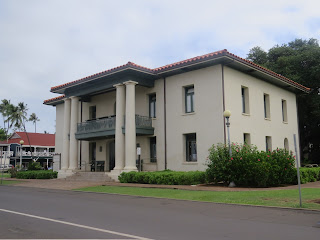Maui, HI, March 17, 2017. It was St. Patrick’s Day in
Lahaina, the oldest town on Maui, and the home of famous Hawaiian kings
Kamehameha and Kamehameha III. I had never been to Maui before, but from
looking at the map I thought we would arrive at the largest town, Kahului.
(Sorry about all the vowels!) Instead,
the ship anchors on the West Coast of Maui. It’s much more culturally
interesting here, and we enjoyed our culture walk in the morning.
Hawaii is quite proud of its time as an independent nation
during the 1800s. It sent out ambassadors to Europe, Asia, and the US and
arranged for trading treaties. But, by and by, sugar plantations grew up, property
was subdivided, and the children of the early missionaries began to institute
Christianity and civilization. That meant things like representative government,
writing, monogamy, metal working, road building, and roofs.
 Still, a lot was done to bury the Hawaiian culture. For
example, in the time when Lahaina was the seat of kings, the village was
organized around a royal island in the middle of a small pond. After Kamehameha
III moved the capital to rapidly growing Honolulu, the king’s huts became
derelict and the pond became a swamp. One of the sugar companies decided to
turn this ancient royal burial ground into a baseball diamond. It had been used
for that purpose for some time until a local cultural movement grew up to
return it to its historical configuration.
Still, a lot was done to bury the Hawaiian culture. For
example, in the time when Lahaina was the seat of kings, the village was
organized around a royal island in the middle of a small pond. After Kamehameha
III moved the capital to rapidly growing Honolulu, the king’s huts became
derelict and the pond became a swamp. One of the sugar companies decided to
turn this ancient royal burial ground into a baseball diamond. It had been used
for that purpose for some time until a local cultural movement grew up to
return it to its historical configuration.
The weather on Maui’s west coast is quite a contrast. The
prevailing weather comes to Hawaii from the Northeast – the well-known Trade
Winds. This means that the mountains are among the rainiest places on the
earth. The coast, however, is a near-desert. Most of the Hawaiian Islands
manage water through the use of cisterns.
On the afternoon, we took a submarine ride. The submarine is
quite small and its propulsion system is just for maneuvering. They tow it to
the dive point in the morning, and tourists take a motorboat from Lahaina.
During the dive we saw coral reefs, impressively large schools of fish, a
bottom-dwelling shark, and a wreck of a sailing ship. At one point a moray eel
peeked out from under a rock.
 We dived to 128 feet, at which point the guide said, “This
is the deepest any of you have gone!” I told him that we would cruise at this
depth for weeks. All jokes aside, however, I was impressed with the level of
technology on this submersible. They have some impressive gas management for
oxygen, carbon dioxide, and carbon monoxide. They also have a variety of
sub-to-surface communication systems. It was a fun experience.
We dived to 128 feet, at which point the guide said, “This
is the deepest any of you have gone!” I told him that we would cruise at this
depth for weeks. All jokes aside, however, I was impressed with the level of
technology on this submersible. They have some impressive gas management for
oxygen, carbon dioxide, and carbon monoxide. They also have a variety of
sub-to-surface communication systems. It was a fun experience. 




No comments:
Post a Comment